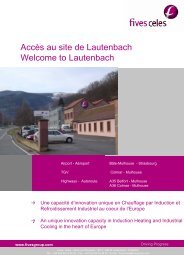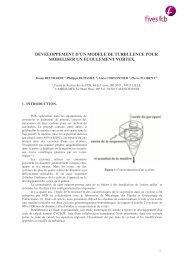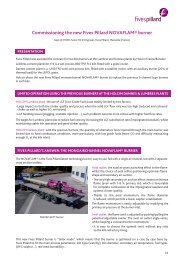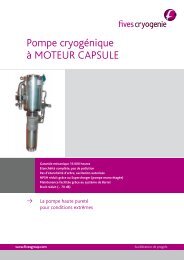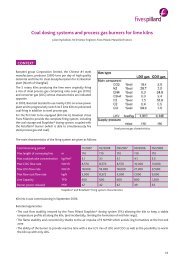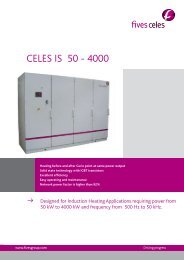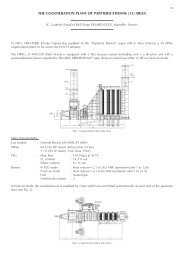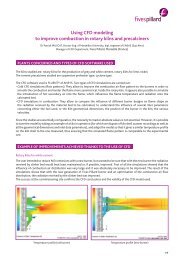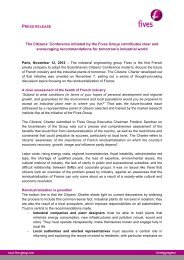NeutriNOx娉 SNCR system for cement plants Optimization of ... - Fives
NeutriNOx娉 SNCR system for cement plants Optimization of ... - Fives
NeutriNOx娉 SNCR system for cement plants Optimization of ... - Fives
- No tags were found...
You also want an ePaper? Increase the reach of your titles
YUMPU automatically turns print PDFs into web optimized ePapers that Google loves.
NeutriNOx®” <strong>SNCR</strong> <strong>system</strong> <strong>for</strong> <strong>cement</strong> <strong>plants</strong><strong>Optimization</strong> <strong>of</strong> the urea / ammonia consumptionCyril Dufau-Sansot, Deputy General Manager, Pillard Feuerungen Gmbh Taunusstein (Germany)Julien Ryckeboer, Senior R’nD Engineer, <strong>Fives</strong> Pillard, Marseille (France)BASIC FACTS ABOUT THE <strong>SNCR</strong> SYSTEMSCurrently, numerous <strong>cement</strong> kilns have nitrogen oxides (NOx) emissions exceeding levels set by future environmentalregulations. <strong>Fives</strong> Pillard, thanks to its NeutriNOx® <strong>system</strong>, provides the adequate solution to reduce NOx emission levelsand thus fulfil the future requirements, i.e.: 500 mg/(n)m 3 @ 10% O 2vol. dry eq NO 2. Cf. European Directive No.2001/81.This solution is based on a Selective Non Catalytic Reduction <strong>of</strong> NOx technique, using ammonia or urea reaction to reduceNOx from the flue gases since the <strong>cement</strong> process NOx emission can not be reduced to the European Directive levels onlywith Low NOx <strong>cement</strong> kiln burners like the Rotaflam LoNOx® type. Then the direct injection <strong>of</strong> diluted urea or ammoniasolution into the hot flue gases helps to reach the target:The <strong>SNCR</strong> principle is the following:Nitrogen oxides NO and NO 2(as NOx), generated during the combustion processes, are reduced by gaseous Ammonia NH3at high Temperature (ranging between 800°C and 1 100°C), thus:4 NO + 4 NH 3+ O 2 4 N 2+ 6 H 2O (R1)6 NO 2+ 8 NH 3 7 N 2+ 12 H 2O (R2)5 O 2+ 4 NH 3 4 NO + 6 H 2O (R3)The reduction reactions R1 and R2 are predominant. However, above 980°C, reaction R3 yields increased NOx, instead <strong>of</strong>reducing the NOx concentration and, as a result, overall efficiency goes down, as shown as follows:DeNOx Efficiency <strong>of</strong> the <strong>SNCR</strong> System: n = (NOx Initial – NOx Final) / (NOx Initial)There<strong>for</strong>e, it is <strong>of</strong> utmost importance to inject the urea or ammonia solution at the optimal gas temperature. As the DeNOxefficiency is a function <strong>of</strong> two parameters, temperature and molecular ratio (NH 3/ NOx Initial), this maximum efficiencylevel is at around 960°C and it can be increased further by refining the molecular ratio.1/8
Why using urea instead <strong>of</strong> ammonia?The reducing agent, gaseous ammonia (NH 3), may be supplied by either: Aqueous solution <strong>of</strong> ammonia ranging from 10 to 35 % (m/m). For a concentration higher than 25 % (m/m) the productis considered in Europe as hazardous and requires compliance with very high level safety measures <strong>for</strong> storage and handling.or Aqueous solution <strong>of</strong> urea ranging from 25 to 45 % (m/m) CO(NH2)2 . Above 200°C the urea decomposes as follows:CO(NH 2) 2+ H 2O CO 2+ 2 NH 3(R0)Given its physical and chemical properties, urea is safer and easier to use. However the efficiency <strong>of</strong> ammonia solution isgenerally higher than urea.There<strong>for</strong>e <strong>Fives</strong> Pillard uses urea as well as ammonia solution base product <strong>for</strong> its NeutriNOx® <strong>system</strong> in <strong>cement</strong> <strong>plants</strong>.Choice, urea and ammonia solution will be made depending on product price, availability from local chemical suppliers andexpected range <strong>of</strong> temperature.The NeutriNOx® main components are both ammonia and urea resistant.ENGINEERINGSITE MEASUREMENTNOx, TEMPERATUREFLUE GAS FLOW MODELLINGTEMPERATURE AND VELOCITY PROFILEATOMIZING MODELLINGLOCATION, NUMBER OF GUNS, PENETRATIONCHEMICAL AND FLOW MODELLINGANALYSIS OF UREA MIX IN THE REACTION ZONE<strong>Fives</strong> Pillard can provide a complete installation from the solution tank to the injectors and has, <strong>for</strong> this purpose, developeda complete engineering process.Site measurement & flue glas flow modellingThrough site temperature monitoring, <strong>Fives</strong> Pillard determines the adequate and appropriate reaction area (<strong>for</strong> existing<strong>plants</strong>). Then, <strong>Fives</strong> Pillard calculates the flue gas balance and simulates the velocity and temperature pr<strong>of</strong>iles in the reactionarea, using CFD (Fluent) as follows:2/8
Velocity and Temperature pr<strong>of</strong>iles at kiln outletAtomizing Modelling & Chemical and Flow ModellingA second phase consists <strong>of</strong> atomization and particles modelling, as well as, efficiency optimization within the reaction area:The number <strong>of</strong> injectors and their location / penetration point(s) are optimized by The FIVES PILLARD “NeutriNOx®” <strong>SNCR</strong><strong>system</strong> as follows:First level: main injectionSecond level optimizationFirst and second level injectors3/8
Injectors & Atomizers<strong>Fives</strong> Pillard injectors are patented devices that have been developed especially <strong>for</strong> this application. They generate a veryfine spray, allowing quick reaction between urea / ammonia and NOx particles as follows.Each injector atomizer will be designed <strong>for</strong> a penetration which will vary according to the location, diameter <strong>of</strong> the duct andother operating parameters.Penetration <strong>of</strong> an injector means the projection <strong>of</strong> the (solution - air) emulsion momentum on the required axis. It representsthe capacity <strong>of</strong> each jet <strong>of</strong> an atomizer to cross and mix with the main flue gas flow as follows.PAtomizerUreaAmmoniaCompressedairPatented <strong>Fives</strong> PIllard injectorThe <strong>Fives</strong> Pillard atomizing device (fluid atomizing type) and NeutriNOx® <strong>system</strong> ensure maximum penetration andconsequently the best mix spread in the reaction area, thanks to: Highly efficient injectors. The Possibility to optimize the atomizer, such as number <strong>of</strong> holes, angles, etc. during the engineering phase. The Possibility to optimize the atomizing parameters without changing the atomizer, by adjusting the atomizing airconsumption and/or water quantity during the commissioning phase. As a result, the risk <strong>of</strong> NH 3emissions at stack isgreatly reduced. These parameters can also be set by the NeutriNOx® control <strong>system</strong>.Injector connected to a duct<strong>Fives</strong> Pillard atomizer & spray4/8
TargetThe modelling target in the engineering phase is covering the complete cross section <strong>of</strong> the duct with the diluted urea /ammonia spray:Pr<strong>of</strong>iles <strong>of</strong> Mass fraction <strong>of</strong> NH 3THE FIVES PILLARD <strong>SNCR</strong> NEUTRINOX® SYSTEMIt includes: tank / control cabinet / skids / 2 levels <strong>of</strong> injection guns with several atomizers.To increase the turn down ratio <strong>of</strong> the injectors and to increase the penetration <strong>of</strong> jets, urea / ammonia solution can bemixed with water. Afterwards this solution is injected and atomized. Depending on the CFD modelling conclusions, thesolution is dispatched through 6 - 10 Nozzles, installed at 1, 2, or more levels in the calciner. Usually two levels are required.While the first level covers the maximum surface and has longest resident time, the second level optimizes reaction andefficiency.The flow rate <strong>of</strong> solution is directly controlled by the NOx emission at stack. The quantity <strong>of</strong> water is controlled to ensurethe highest injection efficiency. Thus, this configuration allows an accurate control <strong>of</strong> the NOx emission at stack thanks tomaintaining the highest penetration efficiency.Flow principle5/8
In addition to temperature pr<strong>of</strong>ile, burner and raw meal inlet position, others parameters are taken into consideration tooptimize the urea / ammonia solution at engineering and commissioning phases, such as (<strong>for</strong> example): Burner Load, NOxCO and O 2content in the flue gas at kiln outlet, secondary air temperature and NH3 emission value at the stack – see aboveDepending on the ammonia or urea solution, tanks have to be heated or cooled internally.<strong>Fives</strong> Pillard can provide unloading units and tanks. To prevent freezing and / or crystallization <strong>of</strong> the urea solution, thetemperature control <strong>of</strong> the tank, as well as, the concentration <strong>of</strong> the urea are defined. In most cases, a 40% concentrationis recommended <strong>for</strong> the NeutriNOx® process.On the other hand, Ammonia has a very low vapour pressure. There<strong>for</strong>e, the ammonia concentration must be carefullydetermined to prevent gasification in the tank, which in this case has to be cooled. Usually, a 25% Ammonia concentrationm/m or lower is best, avoiding the use <strong>of</strong> hazardous product standards to design tanks and handling <strong>system</strong>.First stage injectorsUrea TanksSecond stage urea gunsSITE RESULTS<strong>Fives</strong> Pillard has already installed their NeutriNOx® <strong>SNCR</strong> <strong>system</strong> at a couple <strong>of</strong> <strong>plants</strong>.Applying a methodical approach based on their engineering process, <strong>Fives</strong> Pillard conducted a series <strong>of</strong> comprehensivetemperature measurements that was followed by a complete Fluent® simulation carried out to maximize the DeNOxreaction efficiency on site at ITC Salerno. By analysing the temperature and velocity pr<strong>of</strong>iles in the reaction zone <strong>of</strong> thecalciner, and by optimizing the urea injection (which concerns the choice <strong>of</strong> injection points, number <strong>of</strong> injectors and theirparameters, such as angle, velocity, water concentration, penetration <strong>of</strong> jets, etc.), <strong>Fives</strong> Pillard could determine the idealposition <strong>for</strong> their special injectors, ensuring optimal atomization fineness and future adjustment possibilities (momentum<strong>of</strong> jets and choice <strong>of</strong> angles and holes).Flow control skidPumping unit6/8
Control cabinetFlow meter skidA reduction <strong>of</strong> NOx emission up to 65% has been reached:Salerno plant resultsA second application has been realized in Asia. Due to the high capacity <strong>of</strong> the <strong>cement</strong> line (nearly 5,000 tpd), the engineeringphase led to installing two level with six injectors each. <strong>Optimization</strong>, during commissioning in March 2006, defined theoperating parameters <strong>for</strong> best results in automatic mode. <strong>Fives</strong> Pillard applied the same simulation method as in the ITCSalerno case. Operating the NeutriNOx ® <strong>system</strong> in automatic mode, guaranty to keep the NOx emissions at the stack in arange <strong>of</strong> +/- 5% <strong>of</strong> the set point, and allowing optimal Urea / Ammonia consumption.Other sites were commissioned during 2006 - 2007, among others in Italy, bringing new experience. Numerous kinds <strong>of</strong>calciner technologies (see figure 17) and operating conditions met on site, allowed <strong>Fives</strong> Pillard to refine the CFD modelsand hypothesis used to define the best position <strong>for</strong> the injectors.7/8
Calciner technologiesITC Vibo Valentia is a good example, where data collected during the commissioning period, drove us to change thehypothesis taken and so the position <strong>of</strong> injectors. They will be moved down in the calciner chamber, allowing an increase byabout 15% <strong>of</strong> deNOx reaction efficiency(NOx / NH )reacted 3 injectedProductionTPDGuns level1 + 2Temperatureat level 2Summary <strong>of</strong> <strong>SNCR</strong> resultsMax urea flowrate (L/H)MaxefficiencyMaxreductionITC Salerno 1,315 4 + 4 860°C 720 80% 73%ITC Collefero line 5 1,260 0 + 4 870°C 620 47% 71%ITC Collefero line 6 2,150 0 + 4 930°C 580 57% 60%HOLCIM Hon Chong 4,600 6 + 6 940°C 1,600 26% 50%ITC Vibo Valentia 2,180 4 + 4 870°C 700 15% 38%CONCLUSIONThanks to this genuine technology, <strong>Fives</strong> Pillard has been able to optimize Urea / Ammonia solution consumption, yieldingthe required NOx emission level, while avoiding an excessive consumption <strong>of</strong> solution. This leads to a saving <strong>of</strong> up to 25%<strong>of</strong> solution consumption (compared with non optimized approach), yet keeping the same DeNOx efficiency. In financialterms, that means a NOx reduction cost <strong>of</strong> about 120,000 € per year <strong>for</strong> a 3,225 TPD kiln (based on a cost <strong>of</strong> 90 €/T <strong>for</strong> ureasolution @ 40% m/m).8/8



